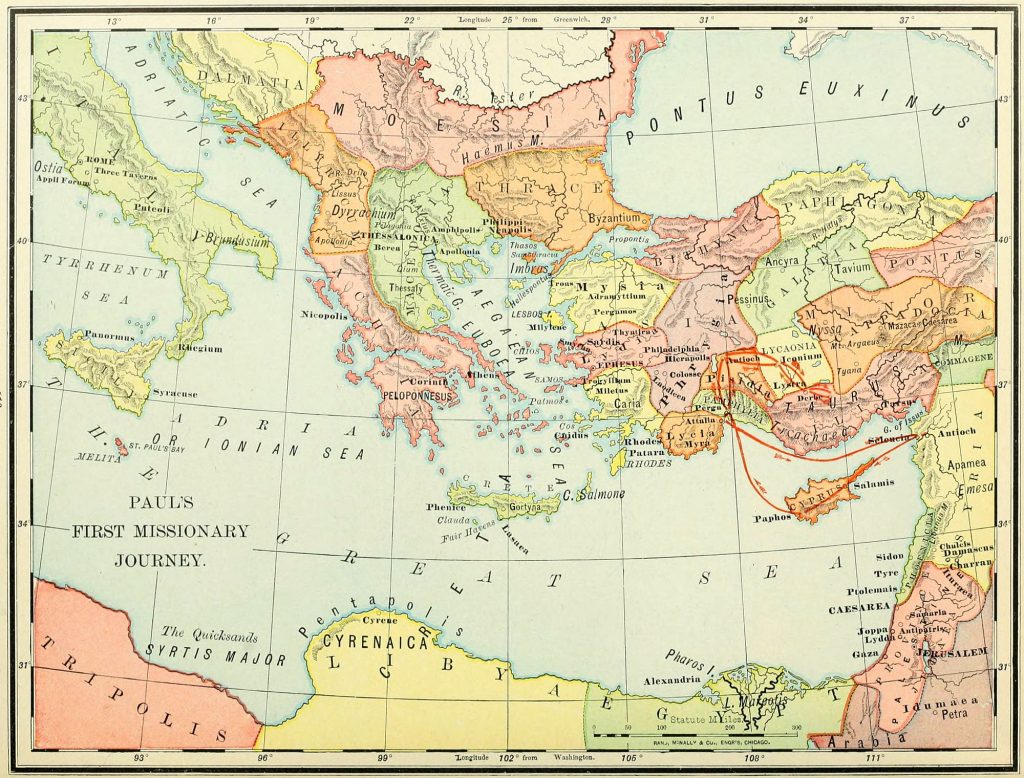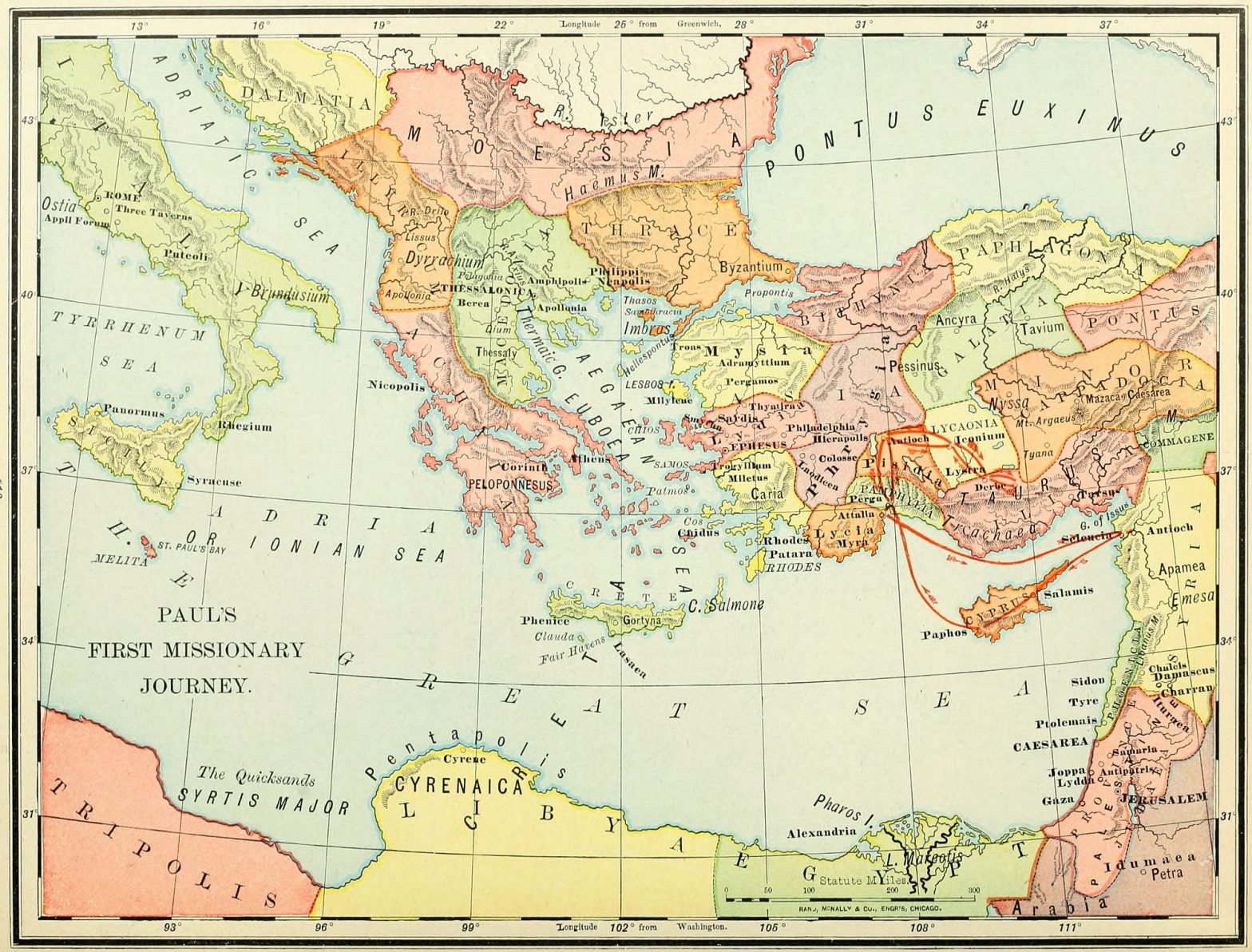
Paul’s first missionary journey is recorded in Acts 13-14. As persecution in Jerusalem increased, Christian believers fled and dispersed throughout the region. Thus Antioch in Syria became a quickly growing church. In approximately AD 47, while the church in Antioch was fasting and worshipping, the Holy Spirit said, “Set apart for me Barnabas and Saul [Paul] for the work to which I have called them” (Acts 13:2). So after praying and laying their hands on them, the church in Antioch sent Paul and Barnabas on their first missionary journey. [compellingtruth.org]

1. Paul and Barnabas, with John Mark as their assistant, set forth upon the first missionary journey from Antioch, the metropolis of Syria (Acts 13:1).
2. They descended the mountains to Seleucia (Acts 13:4), the seaport of Antioch, 16 miles from the city, named from its founder, Seleucus Nicator, B.C. 280. It is now a small village known as el Kalusi, having among its ruins an ancient gateway, still standing, through which Paul and Barnabas may have passed.
3. Setting sail, they crossed over the arm of the Mediterranean to the island of Cyprus (Acts 13:4-13), the early home of Barnabas, 60 miles west of Syria, and 40 miles south of Asia Minor; of irregular shape, 140 miles long and 50 wide; then thickly inhabited, and governed by a Roman proconsul, now under the rule of Great Britain.
4. Their first stopping place was at Salamis (Acts 13:5), on its eastern shore, on the river Pedieos, where they found a Jewish synagogue. The city is now desolate, and its unoccupied site is known as Old Famagousta.
5. They crossed the island from east to west, preaching on their way, and came to Paphos (Acts 13:6), the capital, and residence of the proconsul. This city contained a famous shrine of Venus, to whose worship, with all its immoralities, its people were devoted.
In Paphos, the proconsul, Sergius Paulus, summoned Paul and Barnabas because he “sought to hear the word of God” (Acts 13:7). However, a Jewish false prophet and magician, Elymas, tried to prevent the proconsul from coming to faith. Paul, “filled with the Holy Spirit,” struck Elymas blind thus performing his first miracle (Acts 13:9–11). Upon witnessing this miracle, the proconsul believed.
6. Sailing in a northwesterly direction a distance of 170 miles, they reached Asia Minor, in the province of Pamphylia. Passing by Attalia for the present, they ascended the river Cestrus, and landed at Perga (Acts 13:13), 7½ miles from the sea. This was a Greek city, devoted to the worship of Diana: now in ruins, and called Eski Kalessi. Here their young assistant, Mark, left the two missionaries to prosecute the hardest part of the journey without his help.
7. Their next field of labor was Antioch in Pisidia, a city east of Ephesus, and northwest of Tarsus, now known as Yalobatch. Here Paul preached in the synagogue a discourse reported more at length than any other in his ministry, and here a church was founded. (Acts 13:14-52.) Some Jews contradicted them and stirred up persecution against Paul and Barnabas. After this rejection of the gospel from the Jews, Paul said, “we are turning to the Gentiles” (Acts 13:46). Acts 13:48 records that “when the Gentiles heard this, they began rejoicing and glorifying the word of the Lord, and as many as were appointed to eternal life believed.”
8. Driven out of Antioch by the persecution of the Jews, they went on 60 miles eastward to Iconium, a large city, still in existence as Konieh, and in the Middle Ages the capital of a powerful Mohammedan kingdom. This region, in the apostle’s time, was independent of the Roman empire. (Acts 14:1-5.)
9. Again compelled to endure persecution, they traveled to Lystra, a heathen city in the district of Lycaonia. In Lystra, Paul performed another miracle—healing a man who had been crippled since birth. Unfortunately, the miracle caused the people to believe that Barnabas was the god Zeus and that Paul was Hermes, the messenger and chief spokesman of the gods. Paul and Barnabas had to work hard to convince the people that they were mere men and prevent them from making sacrifices to them. Then Jews from Antioch in Turkey and from Iconium came and persuaded the crowds to stone Paul. After the stoning, Paul was dragged out of the city and left for dead. However, when the disciples gathered around him, he got up and walked right back into Lystra. Acts 14:8-20.
10. Paul having been stoned at Lystra, the apostles went on to Derbe, 20 miles distant, but in the same province, where they were suffered to labor in peace. It is supposed to be represented by the modern village of Divle. This marked the furthest place reached by the evangelists. They were now quite near the pass in Mount Taurus, known as the Cilician Gates, and could easily have reached Tarsus, and thence taken a short voyage home.
11. But they preferred to return by the same route, perilous as the journey was from the enmities excited by their preaching; and revisited Lystra, Iconium and Antioch, confirming the churches which they had planted, and establishing new ones in other neighboring places in Pisidia and Pamphylia, as in Attalia, a seaport on the river Katarrhaktes, 16 miles from Perga, now known as Adalia, where they took ship once more, and thence sailed over the Cilician section of the Mediterranean, north of Cyprus, to Antioch in Syria, where they were gladly received by the church which had sent them forth. Acts 14:21-26.
Compiled from The Rand-McNally Bible Atlas and compellingtruth.org
